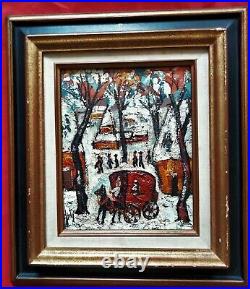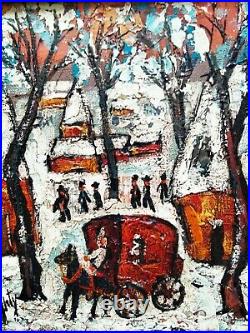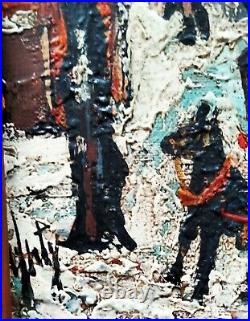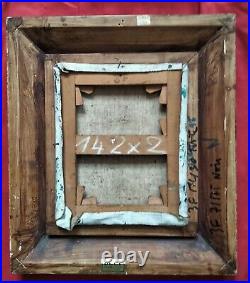




« La calèche devant le village sous la neige « . Signée en bas à gauche d’Anty format hors cadre 22 cm x 27 cm dans son beau cadre 38 cm x 43 cm. D’ANTY, Henry, (Maurice Henry, dit). Présentation : Dessinateur en noir et blanc, il reçoit le choc de la couleur en visitant la Bretagne, au milieu des années 1950, et use dès lors de couleurs violentes et hâtives, à la manière de l’école de Paris. Il peint des paysages, des scènes de genre, des natures mortes et beaucoup de Clown, aux mains énormes, d’un geste souple que n’empêche pas la lourdeur de la pâte. De la même épaisseur mais dans une certaine raideur bordée, il traite des hivers, Petite neige au château ou Théâtre de l’Atelier, sous la neige, s. En revanche, Les Environs de Lille, s. , emploient des huiles mâtinées de gris, lisses. Ses gouaches sont vernies, très souvent, et bordées afin de faire mieux ressortir les figures. Il peint aussi des figures en aplats bordés, cloisonistes. Quelques marines sont plus désinvoltes. Il est l’auteur de toiles religieuses. Expositions : 2000, Salle des fêtes du XIXe, Paris, (G). Born 1910 in Belleville France. Died in December 4 1998. Educated at the Academy de la Grande Chummier and the Academy Julian Paris. Painter of the school of Paris. Painter of de l’Ecole de Paris et Peintre T? Moin de son Temps He participated in numerous exhibitions and was rewarded number of prizes for his work in France and abroad. D’Anty is an artist of rare sensibility. It can be said that his work is the spontaneous and of successive emotions which are profoundly intimate and sincere: hence the exceptional variety of his styles. In order to obtain a better appreciation of the charm and attraction of his work it is helpful to recall some of the phases of his life, without going into the unimportant details. D’Anty was born in Belleville, and it was here that he came to know the picturesque quality of small sloping streets, sometimes broken by flights of steps, like those of Montmartre. Afterwards he moved to Saint Maurice, where he came under the spell of the banks of the Marne with its blue green reflections, the heavy river barges, and the lock with its large dark mass, which all made their impressions, as did a later visit in northern France, long before he thought seriously about painting. But in both eye and mind, he was already storing secret visions and emotions. It is the earliest impressions which leave the deepest mark on a child’s consciousness, still in its full freshness. Later, one remembers, and it is memories, made poetic by their distance in time, which inspire and direct a man’s vocation. Destiny also plays its part, in the form of chance encounters. The young Henry D’Anty happened to meet an elderly man who was drawing, out in the open air, and afterwards, a sculptress who gave drawing lessons. He watched the former, with growing interest, and followed the teaching of the latter. He could hardly have been more fortunate. Who can teach drawing better than sculptors? And as a result, d’Anty still only a boy was developing into an artist. Passionately fond of drawing, he was already showing unusual abilities, and even perhaps signs of exceptional talent. Thus, as a beginning, d’Anty energetically applied himself to working in black and white, thinking only about drawing. Then, during a holiday in Brittany, he discovered an entirely new awareness of colors, or rather of colors of the enchanting, subtle tones which make up the varied atmospheres of the Breton scene. And this was the turning point. He yielded ; he abandoned himself to the bewitching charm ; he became a painter. This sensitiveness to beauty, this obedience to the voice of inspiration, spring from the essential qualities of d’Anty’s temperament: sensibility, delicacy of feelings. We once read one of his letters to his mother, a delightful letter, written at the age of about thirteen, in which the most moving tenderness is accompanied by the judicious shrewdness of his descriptions of the countryside where he was spending his holidays. Here, then, was this very young painter, ready to penetrate beyond the outward appearances and into the very soul of Nature. To this he was to devote himself, gathering together the manifold aspects of Nature, painted from the life, and above all, meditating on his memories ; he was also to bring to life again the early impressions which were slumbering in his subconscious. And images crowded in upon him: gamins in Belleville ; banks of the Marne, with the black shades of the river lock; unfriendly plains of northern France, and the silken tones of Brittany. D’Anty observed intensely: he saw again his childhood, his moments of wonder, of nostalgia, and he interpreted all into blank pieces of cloth to invite us into, his, our world. Thomas, Prefet de La Rochelle. Mme de Rovera, Paris. Mme la Duchesse de Medina Seli, Madrid. Mme Lucie Utrillo Valore. La Heine Marie Josd d’Italie. Marie, ancien President du Conseil, Paris. Mme Semiha Huber Hassanzade, Zurich. Dr Nizier Cottarel, Paris. Durat, Jouet sur I’Aubois. Colonel et Madame Garbish Chrysler, New York. La Princesses Ashraf Pahlevi. Prince Carol de Hohenzollern, Paris. Mme Maryl6ne David, Paris. Samuel Weiss, New York. Mme Anne Cutler, Virginia. Le Prince Karim Aga Khan. 1949 Galerie de Ptquipe, rue Saint Rustique, Montmartre. 1950 Galerie Lebar, rue Uon Jost, Paris. 1951 Galerie Hermann, rue des Beaux Arts, Paris. 1952 Galerie Lebar, rue Ldon Jost, Paris. 1953 Galerie de la Maison des Beaux Arts, Paris. 1954 Galerie de l’Institut, rue de Seine, Paris. 1955 Galerie Duncan, rue de Seine, Paris. 1956 Galerie Clio, Nice. 1957 Galerie Mourgue, avenue de I’Opéra, Paris. 1957 Mairie de Barentin. 1958 Galerie Schneider, avenue Matignon, Paris. 1958 Caves de la Tour Eiffel, rue Charles Dickens, Paris. 1959 Scala Nebli, Madrid. 1960 Musée de I’Athdride, Geneve. 1960 Galerie Stoliar, Cannes. 1961 Palais de la Mdditerrande, Nice. 1961 Galerie Cadror, Berne. 1961 Cimaise du Vieux Colombier, Paris. 1962 Dickson Galerie, Washington. 1962 Galerie 16, Saint Antoine, Cannes. Merci de m’ajouter à votre liste de favoris! Consultez mes autres objets! Portraits, marines, paysages, natures mortes… Près de 600 tableaux en permanence!!! Une visite s’impose. Le paiement de votre achat devra me parvenir impérativement dans un délai de 3 jours à la date de votre acquisition. Cet item est dans la catégorie « Art, antiquités\Art du XXe, contemporain\Peintures ». Le vendeur est « janys007″ et est localisé dans ce pays: FR.
- Caractéristiques: Encadré, Signé, Sur toile
- Artiste: HENRY D’ANTY
- Genre: Expressionnisme
- Thème: Paysage
- Type: Huile

Incoming search terms:
- https://tableaupeinturesurtoile com/belle-huile-par-henri-danty1910-1998-la-caleche-pres-du-village-sous-la-neige/
